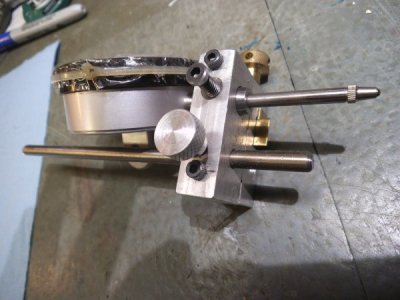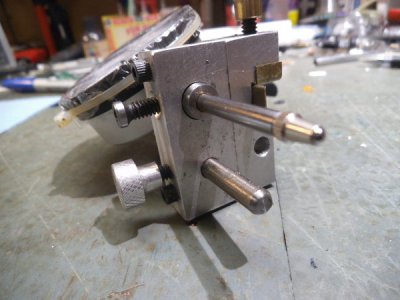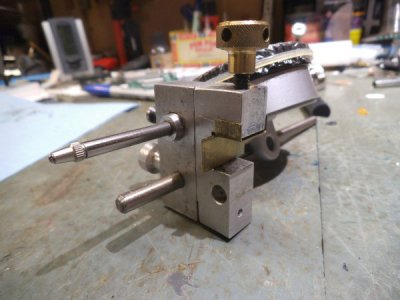-
Welcome back Guest! Did you know you can mentor other members here at H-M? If not, please check out our Relaunch of Hobby Machinist Mentoring Program!
You are using an out of date browser. It may not display this or other websites correctly.
You should upgrade or use an alternative browser.
You should upgrade or use an alternative browser.
Carriage Stop
- Thread starter minsk
- Start date
- Joined
- Oct 10, 2018
- Messages
- 545
No, no, not my pages. Just something that a web search led me to. The main page says "Copyright 1998-2012 Dean Williams".great projects on your page craig.
inspiring to a noobie.

Craig
- Joined
- Nov 18, 2012
- Messages
- 1,352
I'd very much like to see more details.
Craig
Just remember as hobbyists, we may have more time than money, and often just scrap lying around. I made mine out of two pieces since I didn't have a piece large enough. I have tonnes of fasteners so often fabricate stuff from multiple pieces rather than one larger on. This is also useful if you don't have a mill. You can cut shapes from two pieces with a hacksaw and join the pieces eliminating the need for a mill.
Here are close ups of mine. I wanted the tightening cap to be above or easy access so added a brass piece to protect the ways from the screw.



David
- Joined
- Oct 10, 2018
- Messages
- 545
Looking good! The multi-part construction explains some of the 'extra' screw heads!Just remember as hobbyists, we may have more time than money, and often just scrap lying around. I made mine out of two pieces since I didn't have a piece large enough. I have tonnes of fasteners so often fabricate stuff from multiple pieces rather than one larger on. This is also useful if you don't have a mill. You can cut shapes from two pieces with a hacksaw and join the pieces eliminating the need for a mill.
Here are close ups of mine. I wanted the tightening cap to be above or easy access so added a brass piece to protect the ways from the screw.
View attachment 284971View attachment 284972View attachment 284973
David
How is the brass clamp retained?
Any trouble with it slipping when the carriage runs into the hard stop? It looks like it might pivot a little on the oily ways if one was a bit ham-handed approaching the stop.
Craig
- Joined
- Nov 18, 2012
- Messages
- 1,352
Craig, Thanks. Yes could have used less obtrusive fasteners for sure.
If you look at the brass piece closely it has "wings" bent up to trap it when sliding along the ways and is also bent 90 deg and down to be trapped between the edge of the way and holder.
There are holes drilled in the thumb screw for use with a tommy bar to provide extra clamping force if required. However I feel it is ok to be able to swivel out of the way IF one misjudges while power feeding and it runs into the stop. Rather it move than strip something. So it can be tightened adequately in my opinion.
David
If you look at the brass piece closely it has "wings" bent up to trap it when sliding along the ways and is also bent 90 deg and down to be trapped between the edge of the way and holder.
There are holes drilled in the thumb screw for use with a tommy bar to provide extra clamping force if required. However I feel it is ok to be able to swivel out of the way IF one misjudges while power feeding and it runs into the stop. Rather it move than strip something. So it can be tightened adequately in my opinion.
David
- Joined
- Oct 10, 2018
- Messages
- 545
Ahh, when I first looked, I thought that was a sizeable brass bar as a clamp. I see the bends, now.
Good point about hitting it under power. I was thinking about turning/facing a shoulder or boring to a depth. Wouldn't want it to 'wander' after knocking it a couple of times.
Thanks again for all the info. I really want to make something like this.
Craig
Good point about hitting it under power. I was thinking about turning/facing a shoulder or boring to a depth. Wouldn't want it to 'wander' after knocking it a couple of times.
Thanks again for all the info. I really want to make something like this.
Craig
- Joined
- Nov 18, 2012
- Messages
- 1,352
The other thing is that you can also set the indicator to 0 at the same place as the carriage stop. This way you can see if the stop is moving.
EDIT:
Folks this is not correct! Since the dial indicator and the stop rod are in the same block if the block moves so does the indicator, so movement will NOT be detected on the dial.
However if the stop rod is not secured in the block and it moves but the block stays stationary on the ways then this condition will be recorded on the dial.
Woke up this morning and expected to be flamed by my original statement.
David
EDIT:
Folks this is not correct! Since the dial indicator and the stop rod are in the same block if the block moves so does the indicator, so movement will NOT be detected on the dial.
However if the stop rod is not secured in the block and it moves but the block stays stationary on the ways then this condition will be recorded on the dial.
Woke up this morning and expected to be flamed by my original statement.
David
Last edited:
Here's my version, but it's for my little Dunlap 6" with v ways. It has a stop bar hole, dial indicator mount hole, and the two little screws on top mount a modified 6" caliper that works as a diy DRO.

Sent from my H3123 using Tapatalk

Sent from my H3123 using Tapatalk
- Joined
- Oct 10, 2018
- Messages
- 545
Well, I guess you can make up for your boo-boo by sending me your stop!The other thing is that you can also set the indicator to 0 at the same place as the carriage stop. This way you can see if the stop is moving.
EDIT:
Folks this is not correct! Since the dial indicator and the stop rod are in the same block if the block moves so does the indicator, so movement will NOT be detected on the dial.
However if the stop rod is not secured in the block and it moves but the block stays stationary on the ways then this condition will be recorded on the dial.
Woke up this morning and expected to be flamed by my original statement.
Still a nice easy design and I've saved your pics in my ideas folder.
Craig
